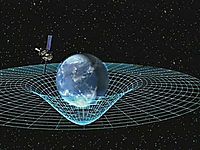
Photo from wikipedia
Ultralight axion like particles (ALPs) of mass m_a∈ (10-21 eV–10-22 eV) with axion decay constant fa∼ 1017 GeV can be candidates for fuzzy dark matter (FDM). If celestial bodies like… Click to show full abstract
Ultralight axion like particles (ALPs) of mass m_a∈ (10-21 eV–10-22 eV) with axion decay constant fa∼ 1017 GeV can be candidates for fuzzy dark matter (FDM). If celestial bodies like Earth and Sun are immersed in a low mass axionic FDM potential and if the ALPs have coupling with nucleons then the coherent oscillation of the axionic field results a long range axion hair outside of the celestial bodies. The range of the axion mediated Yukawa type fifth force is determined by the distance between the Earth and the Sun which fixes the upper bound of the mass of axion as ma≲10-18 eV. The long range axionic Yukawa potential between the Earth and Sun changes the gravitational potential between them and contribute to the light bending and the Shapiro time delay. From the observational uncertainties of those experiments, we obtain an upper bound on the axion decay constant as fa≲ 9.85× 106 GeV, which is the stronger bound obtained from Shapiro time delay. This implies if ALPs are FDM, then they do not couple to quarks.
Journal Title: Journal of Cosmology and Astroparticle Physics
Year Published: 2021
Link to full text (if available)
Share on Social Media: Sign Up to like & get
recommendations!